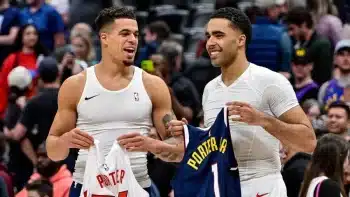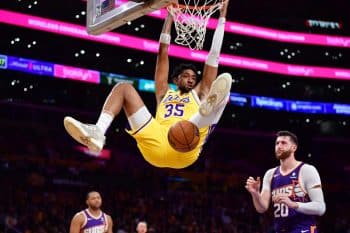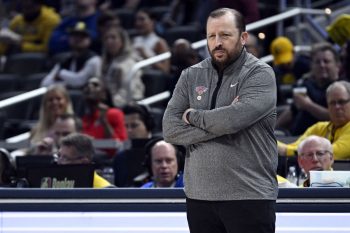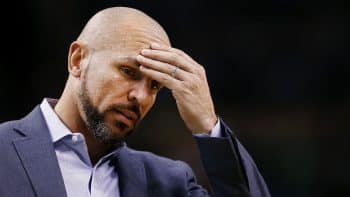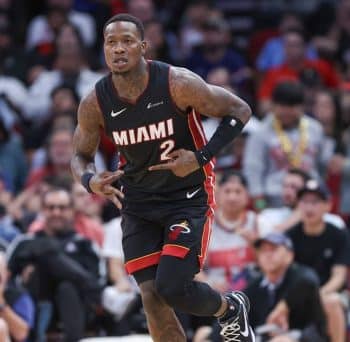NBA
NBA Daily: Five Stats To Keep An Eye On Revisited

Before the season, Basketball Insiders pinpointed five statistics that could be worth watching in the 2019-20 season. These statistics each helped tell the story of last season and could be vital in determining the standings of the current campaign.
A month into the season, here’s an update on how those five statistics, and the impact they’ve had thus far.
Philadelphia 76ers — Forced Turnover Percentage
After starting the season 5-0, the Philadelphia 76ers fell a bit back down to earth and are now sitting at 8-5. Some of the regression can be blamed on a Joel Embiid suspension and a Ben Simmons shoulder sprain, but there have been some legitimate areas of concern over the last eight games.
Their defense, which was operating at an elite level during the first five games, has fallen now to a good-not-great 11th in the league. Interestingly, their forced turnover percentage has not been the culprit for the decline.
The 76ers are up to 11th in the league in forcing turnovers this season after finishing 28th in that category in 2018-19, per Cleaning the Glass. The new additions Josh Richardson and Matisse Thybulle, along with an increase in aggressiveness on that end from Simmons, have been in key in forcing loose balls and errant passes.
While this is encouraging, the increased aggressiveness may be a direct factor in one of their biggest flaws over the first 13 games. The 76ers are currently 29th in the league in opponent free throw rate, giving up 25.1 free throws per 100 possessions, per Cleaning the Glass.
A high foul rate can be seen as a necessary risk for this 76ers team. An increase in turnovers could lead to more transition opportunities, which could help an offensively-challenged team generate more easy baskets.
So far, though, the risk has not been worth the reward. Despite going from 28th to 11th in forced turnover percentage, the 76ers efficiency and frequency in transition have remained relatively the same. They’ve generated transition opportunities off of 68.4 percent of their steals, just one percentage point higher than last season, per Cleaning the Glass. These opportunities have netted them an additional 1.7 points per 100 possessions, only slightly better than last season’s number of 1.6.
For Philadelphia to get back on track, something will have to change. Going forward, it will be important to see if the 76ers can keep up their rate of forcing turnovers while simultaneously reducing their foul rate and generating more transition plans.
Los Angeles Lakers — Half Court Efficiency
The Los Angeles Lakers have jumped out to an 11-2 record and sport the best net rating in the league. They have done so with a very impressive defense that ranks second in the NBA through the first month.
Meanwhile, their offense hasn’t lagged too far behind, as they rank 7th in the league on that side of the ball. Last season, the Lakers struggled offensively, particularly in the half-court where they were unable to consistently generate open looks.
They were a particularly bad shooting team in 2018-19, finishing last season with an overall three-point percentage of only 34 percent. The Lakers were expected to improve in that department this season with multiple shooters being brought into the fold.
But, while the team has taken a step offensively, it hasn’t been because of their shooting.
While Danny Green has been a marksman, shooting 42.2 percent from three, the rest of the Lakers’ roster has not been up to snuff. Overall, they sit at exactly the same percentage as last season when it comes to three-point shooting, 34 percent.
Their offense has been humming thanks to some old-fashioned domination around the rim. The Lakers are shooting 40.4 percent of their total shots at the rim and finishing 69.1 percent of those attempts, per Cleaning the Glass.
That kind of efficiency around the basket will mitigate any shooting concerns. But, if some of the Lakers’ role players can begin to hit their outside shots, the Los Angeles offense could prove even more imposing.
Denver Nuggets — Opponents’ Effective Field Goal Percentage
One of the harder to project statistics in the NBA is the opponents’ field goal percentage. This number can vary from year-to-year for no reason other than luck.
Last season the Nuggets improved their defense greatly and went from one of the worst units in the league to an average one. But, when digging into some of their numbers, it became clear that some of this may have been due to a lucky streak of opponent shooting, as the Nuggets gave up very similar looks to those they gave up in 2017-18, but opponents simply shot a worse percentage on these attempts.
This season, the Nuggets’ defense has improved even further. They are currently holding opponents to an effective field goal percentage of 49 percent, third in the league, per Cleaning the Glass.
The Nuggets give a few too many threes, particularly from the corner, but opponents haven’t punished them as they’ve shot just 32 percent overall from three against Denver.
So, looking at the tracking data on NBA.com, it would appear as if some of that luck has carried over from last season. The Nuggets are giving up about the same number of wide-open three-point attempts as last season. On these attempts, opponents are shooting 37.1 percent, which is slightly under the 37.6 percent they managed last season.
That number is not extremely lucky, as 11 NBA teams have had better luck than Denver on wide-open shots this season. Where the Nuggets have gotten particularly good bounces, however, is on open shots, classified as those attempts when a defender 4-6 feet away. On these attempts, opponents are shooting just 26.5 percent, good for the second-lowest number in the league.
The Denver defense has certainly improved this season, but it’s unlikely they maintain their current pace in terms of opponent shooting.
Milwaukee Bucks — Offensive Rating without Giannis
One of the big reasons for the Milwaukee Bucks’ success last season was the performance of their bench. While Giannis Antetokounmpo was certainly the conductor of the team’s attack, the team fared very well when he hit the bench.
But, with the departure of Malcolm Brogdon, there were some who questioned how the team would perform without their MVP on the court. And, so far, it appears as if those reservations were valid, to a point.
This season, the Bucks have felt the loss of Brogdon quite a bit, but not in an overly drastic way. When Antetokounmpo is on the floor, the Bucks boast about a 112 offensive rating, compared to a 107 rating when he sits, per Cleaning the Glass.
Last season, the difference dropped about three points, from 116 when Antetokounmpo was on to 113 when he was off.
Milwaukee’s offense stayed at an elite level last year when Antetokounmpo sat on the back of impressive three-point shooting. But, this season, the Bucks have been getting up a similar number of attempts when he sits, but the shots have just haven’t fallen. From 2018-19 to 2019-20, the bench’s three-point percentage has dropped from 37.4 percent to 32.1 percent, per Cleaning the Glass.
While this is partially attributed to the loss of a 40 percent three-point shooter in Brogdon, the Bucks still have a plethora of solid shooters who should be able to hit more shots as the reigning MVP rests. As the season goes on, it wouldn’t be a shock to see these numbers level out in their favor.
Houston Rockets — Second Half Net Rating
After starting the season in a bit of a rut, the Houston Rockets have ripped off eight straight wins and have played about as well as many expected them to coming into the season. Like last year their success could be attributed mostly to a dominant James Harden, who’s averaged 40 points per game in that stretch.
Last season, the Rockets would often get out to a hot start, but struggle thereon and occasionally give up leads in the second half. The culprit of the second half malaise was theorized to be a tired Harden, given his gargantuan workload, or perhaps a predictable style of play that opponents would catch on and adjust to after a couple of quarters.
Whatever the reason, the addition of Russell Westbrook was to serve as a potential antidote. Last season, Westbrook’s Thunder excelled in the second half of games, as his seemingly boundless energy had a way of wearing opponents down as games went on.
And, in fact, the Rockets have proven much more assertive in second halves. They are currently sporting a 2.2 net rating in the first half, a number that has improved to 3.6 in the second, per NBA.com.
While Harden has continued to take a lion’s share of the work, Westbrook has added a transition threat to the Houston offense and has certainly played a key role in its improvement. If the Rockets can maintain this energy and efficiency throughout entire games, they could prove a major threat come April and May.
Those five statistics are just a few of the interesting trends and storylines to follow across an 82-game season. So, be sure to check back with Basketball Insiders to follow them along.
